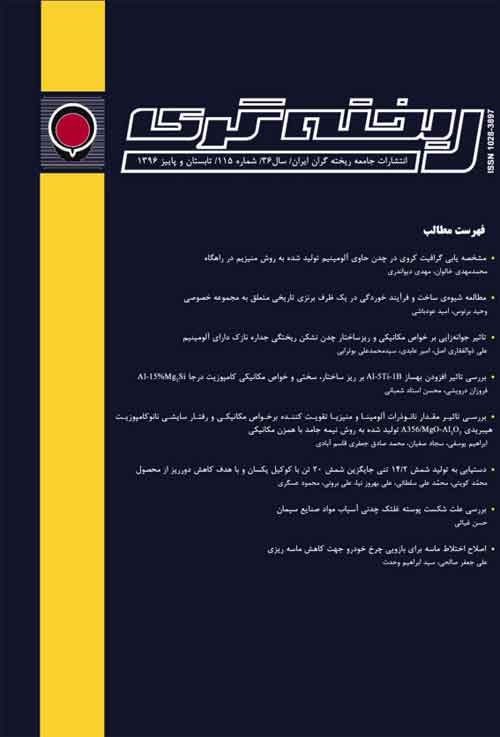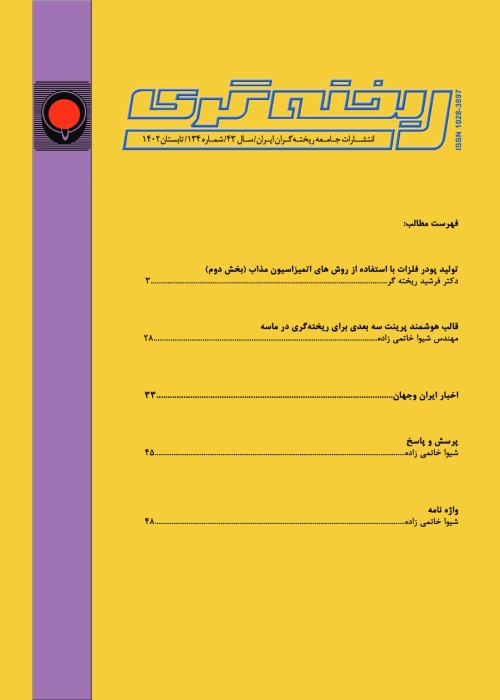فهرست مطالب

نشریه ریخته گری
پیاپی 115 (تابستان و پاییز 1396)
- تاریخ انتشار: 1396/09/30
- تعداد عناوین: 8
-
-
مشخصه یابی گرافیت کروی در چدن حاوی آلومینیوم تولید شده به روش منیزیم در راهگاهصفحه 2
-
مطالعه شیوه ی ساخت و فرآیند خوردگی در یک ظرف برنزی تاریخی متعلق به مجموعه خصوصیصفحه 10
-
تاثیر جوانه زایی بر خواص مکانیکی و ریزساختار چدن نشکن ریختگی جداره نازک دارای آلومینیمصفحه 17
-
بررسی تاثیر افزودن بهساز Al-5Ti-1B بر ریز ساختار، سختی و خواص مکانیکی کامپوزیت درجا Al-15%Mg2Siصفحه 25
-
بررسی تاثیر مقدار نانوذرات آلومینا و منیزیا تقویت کننده بر خواص مکانیکی و رفتار سایشی نانو کامپوزیت هیبریدی A356/MgO-Al2O3 تولید شده به روش نیمه جامد با همزن مکانیکیصفحه 32
-
دستیابی به تولید شمش 14/2 تنی جایگزین شمش 20 تن با کوکیل یکسان و با هدف کاهش دورریز از محصولصفحه 41
-
بررسی علت شکست پوسته غلتک چدنی آسیاب مواد صنایع سیمانصفحه 45
-
اصلاح اختلاط ماسه برای بازویی چرخ خودرو جهت کاهش ماسه ریزیصفحه 52
-
Characterization of NodularGraphite in Aluminum Cast Iron Produced via In-Mold ProcessPage 2In this research, the effect of various amounts of aluminum on morphology of graphite in ductile cast irons produced by in-mold casting process is investigated. For this purpose, spherical graphite cast iron containing 0, 3.7, 5.5, 6.4 and 7.5 wt. % aluminum, respectively, were prepared in Y-block form via in-mold process. After casting, samples were prepared for microstructural studies, using conventional methods, followed by optical microscopy (OM) examination. Chemical composition of samples were determined using quantometer, x-ray fluorescence spectroscopy (XRF) and carbon/ sulfur determination method. Increasing the number of spheres from 168 to 668 per square millimeter, reducing the grain size from 21.4 to 8.8 micrometers, and changing the percentage of spherical graphite from 65 to 48 percent was observed.Hardness of samples show increase from 284 to 482 Vickers by increasing aluminum content from 0 to 7.5 weight percent.Keywords: Spherical Graphite Cast Iron, Aluminum, In-mold process, Microstructure, Graphite, hardness
-
Study on Manufacturing Technique and Corrosion on a Historical Bronze Vessel from a Private CollectionPage 10Historical objects obtained from illegal excavations usually have no certain historical and archaeological information and identifying their manufacturing technique and corrosion mechanism requires analytical studies in order to recognize their various aspects. The studied object in this research is a three-legged metallic vessel, which belongs to Babakhanis private collection. To identify manufacturing technique and objects, condition in term of corrosion mechanism, the object was studied and analysed by using methods such as metallography, X-ray radiography, and instrumental analyses (SEM-EDS and XRD methods). The results of the study states that the object is made of tin bronze alloy, containing high amount of lead (Leaded Bronze) and it has a twophase microstructure comprise of bornzed background as well as big lead globules that are formed as segregated solid phases in alloy. Basedon the microstructure, the object is manufactured by casting operation in one piece. Regarding presence of paratacamite as a corrosion product, bronze disease is determined as the main corrosion mechanism. Intergarnular Corrosion into grain boundaries in the microstructure is visible showing penetration of corrosion in the structure of the metallic object.Keywords: Bronze Vessel, Leaded Bronze, Casting, Bronze Disease, Paratacamite
-
Effect of nucleation on microstructure formation and mechanical properties of thin wall Aluminum-containing ductile cast ironPage 17Ductile iron castings possess relatively high tensile strength, good ductility and some attractive properties, such as castability, machinability, wear resistance and impact resistance, as compared to those of steel castings. Two main concerns in producing these thin-walled specimens have been related to problems in filling mold and formation of the eutectic carbide. This study was investigated the effects of nucleation and the type of inoculant on the matrix and mechanical properties of aluminum-containing thin-walled ductile iron sections. The melts were prepared with chemical composition of CE=4.54 and 0.1 to 10mm thick strips were cast with Five types of inoculants including Superseed, Zirsinoc, Barinoc, charcoal powder and pure ferrosilicon at 1345° C pouring temperatures. The results from thermal analysis were shown that the cooling rate of aluminum- containing ductile cast iron is faster than silicon-including ductile cast iron; furthermore, aluminum caused a fine dendritic structure, along with nucleation, culminated to more favorable mechanical properties in contrast with silicon-including ductile cast iron. The tensile test and Brinell hardness test were executed on strap band samples with 5, 8 and 10 millimeter thicknesses. Finally, the samples which were inoculated with Barinoc, the best tensile strength (624 MPa) and the lowest hardness were achieved.Keywords: Aluminum-containing ductile cast iron, Thin-walled Nucleation, Mechanical properties, Microstructure
-
Effect of adding Al-5Ti-1B masteralloy on microstructure, hardness and mechanical characteristics of the in-situ Al- 15%Mg2Si compositesPage 25In the present study, microstructural and mechanical charachteristics of the in-situ Al-15Mg2Si composites, modified by using Al-5Ti-1B master-alloy is studied. In-situ technique is used for producing Al-15Mg2Si composite samples with different addition levels of the Al-5Ti-1B master-alloy (0, 0.01, 0.05, 0.1, 0.3, 0.5 and 1wt.%). Therefore, microstructural observations showed that size of the primary Mg2Si particles we reduced considerably after addition of the master-alloy. Also, their shape was slightly modified from dendritic irregular particles to polygon-like particles. Subsequently, tension test was carried out and (except the sample with 1.0wt% addition), a remarkably consistent improvement of the tensile strength, strain to failure, energy absorbtion and hardness was observed for all of the modified composite samples. This was mainly related to the smaller size of the reinforcement phase (Mg2Si) and also better integrity of the matrix/reinforcement interphase. Fracture surface of the composite samples showed a smooth surface, corresponding to cleavage fracture of the unmodified sample. While, with regard to the modifiled samples, fracture surface was considerably altered and a relatively ductile fracture was observed. Findings of this research could be of significant importance, since unlike other methods of refining microstructure and mechanical properties of the in-situ produced alloy under study, we use a relatively inexpensive material, while achieve almost similar properties to them.Keywords: Composite, In-situ technique, Master-alloy, Microstructure
-
Investigation on Effect of Al2O3 and MgO nanoparticles amount on the mechanical properties and tribological behavior of A356/MgOAl 2O3 hybrid nanocomposite produced by semi-solid processing with mechanical stirrerPage 32In this study, the A356/MgO-Al2O3 hybrid nanocomposite was produced by semi-solid processing with mechanical stirrer. The effect of Al2O3 and MgO nanoparticles amount nanoparticles on the microstructure, hardness, impact resistance, and the wear resistance of nanocomposite samples were studied. At first, a stable suspension from nanoparticles with different amounts was prepared, and dispersed on aluminum sheets. Then, samples were mixed in a temperature range of 635-630 °C by mechanical stirrer, and were pressed under a hot pressing process. The microstructure and distribution of nanoparticles in nanocomposite specimens was studied by scanning electron microscopy (SEM) and surface elemental analysis (MAP). Also, the mechanical properties of samples were studied by means of Vickers microhardness tester, impact resistance tester, and the wear testing instrument of pin-on-disk type. The results show that the distribution of nanoparticles by use of stabilized suspensions with surfactant leads to a better distribution and decreases in the agglomeration value. Also, the use of lower temperature in the semi-solid processing, and the addition of nanoparticles leads to improve the mechanical properties of nanocomposite samples compared to non-composite A356 samples. By increasing the weight percent of alumina nanoparticles, the hardness was increased, the coefficient of friction and wear rate were decreased. Moreover, the A75M25 nanocomposite sample with hardness of 137 HV, the coefficient of friction of 0.61, and the wear rate of 0.6133×10-3 (mg/Nm) exhibited the best mechanical properties compared to all the nanocomposite samples.Keywords: nanocomposite, semi-solid processing, suspension, ceramic nanoparticles, coefficient of friction
-
Achieving the production of ingot of 14.2 tons replacing of ingot of 20 tons with the aim of reducing the waste of the productPage 41One of the important concerns of large steel factories is to reduce or save the melting material to produce a quality product. Molds, in the bottom pouring ingot line are parts of the consumed industrial by the ingot mills. In this study studied the production of 14.2 tons of ingots instead of 20 tons of ingots for 11 tons product in the same mold and as pouring bottom ingot. The results showed, the production of 14.2 tons of ingots for 11 tons product in single 20-ton mold is feasible and reduce primary melting will be about 2.5 tons in pouring ingot.Keywords: Bottom pouring ingot, Reducing the waste of the product, 14.2 tons mold
-
The Cause of Failure of Cast Iron Roller Shell for Grinding of Materials in Cement IndustriesPage 45The rollers of materials grinding in cement industries are often exposed to wear and strike of minerals. Therefore, toughness and hardness are the most important mechanical parameters in these rollers. On the other hand, the most original factors affecting to these two parameters are the chemical compound & microstructure. In these study, for investigation of the cause of failure of shell one of these rollers, the chemical compound & microstructure and their influence were studied by using of chemical analysis, microstructure studying and hardness measuring. The results of these tests and fracture surface study by SEM showed that the main reasons of failure were microstructure faults & coarse needle like carbides in matrix of plate like martensite.Keywords: Roller Shell, White Iron, Microstructure, Wear, Hardness
-
Modifying the Sand Composition for the Wheel Brake for Decreasing the Sand DefectPage 52In industries, many different processes or manufacturing methods are used. Casting is considered as one of the most ancient processes of manufacturing metallic components. Metal casting is one of the oldest manufacturing methods. There is different parts product by this method including vehicle safety parts like room arm, room support, wheel arm. The purpose of this research is decrease sand defect in the green sand molding of wheel arm Peugeot 206. In this study, different composition of green sand investigated with change of new sand percentage (1.5-2.5), bentonit percentage (0.5-0.9) and coal dust percentage (0.1-0.3). Results showed that green sand mixtures containing of 1.5% new sand, 0.7% bentonite and 0.1% coal dust have optimum conditions relative to the control sample.The composition has a compressive strength 1950 g/Cm2, compact ability 40% and permeability 186 Cm3/min. Also, by changing molding process and repair that we decrease sand defect in wheel arm Peugeot 206 from 1.44% to 0.8%.Keywords: Green sand, Bentonite, Coal dust, Compression strength, Compact ability, Permeability


